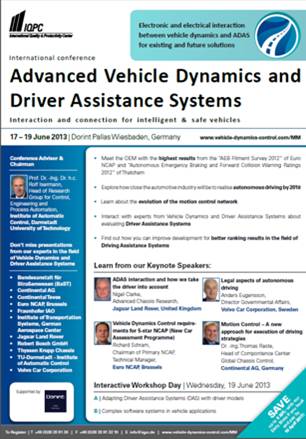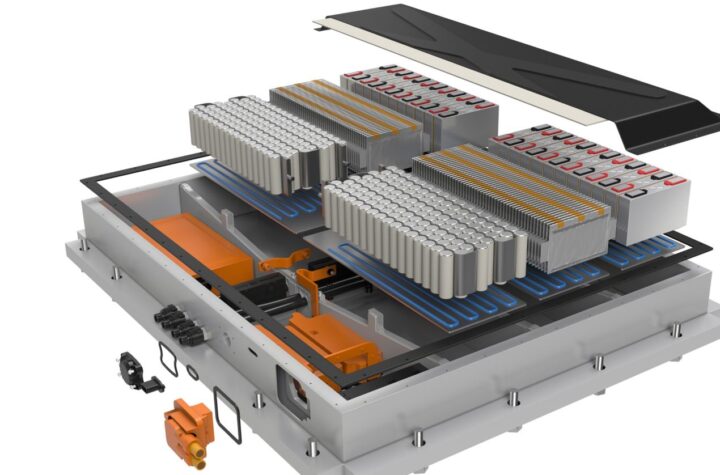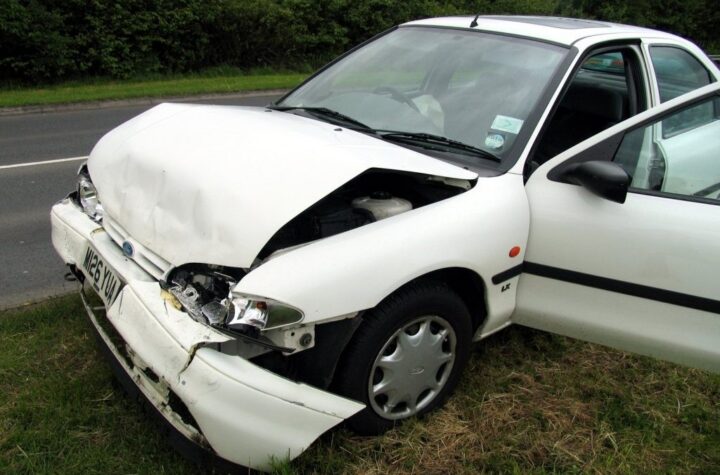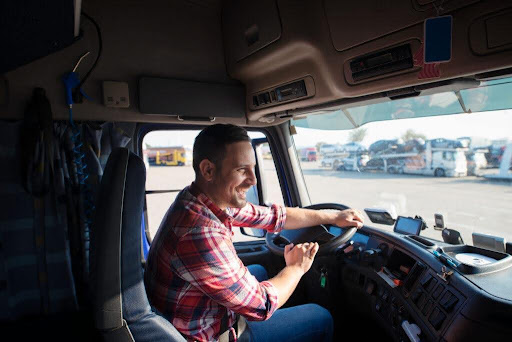
Industry thought leaders and experts will be helping the automotive industry to manage the growing system complexity within increasingly automated and connected vehicles at conference on Advanced Vehicle Dynamics and Driver Assistance Systems being hosted by the International Quality and Productivity Centre (IQPC) from June 17 to 19 in Wiesbaden, Germany.
Applications such as Lane Departure Warning (LDW) and Lane Keeping Support (LKS), object detection and verification to support and improve sensor-based functions like Adaptive Cruise Control (ACC) and the Emergency Braking System (EBS), Forward Collision Warning (FCW) as well as driver drowsiness detection lead to new challenges for vehicle dynamics, according to the organizers.
The conference will include discussion around case studies from OEMs and Tier1s on Euro NCAP tests and the impact on new vehicle dynamics technology. Other topics include new development of driver, vehicle, and infrastructure integration, challenges for autonomous vehicle function, emergency braking and significant effect on the vehicle dynamics and 360-Degree sensing and its requirements for system design and architecture.
Featured speakers at the conference include Prof. Dr. Rolf Isermann, Head of Research Group for Control, Engineering and Process Automation Institute of Automatic Control, Darmstadt University of Technologyy; Anders Eugensson, Director Governmental Affairs Volvo Car Corporation, Sweden; Richard Schram, Chairman of Primary NCAP, Technical Manager EURO NCAP, Brussels, Belgium; Dr Patrick Seiniger, from Active Vehicle Safety, Emissions, Energy Bundesanstalt für Straßenwesen (BASt); and Nigel Clarke (Chartered Engineer MIET) from Advanced Chassis Research Jaguar Land Rover, United Kingdom.
The two day conference will cover topics such as vehicle dynamics control for autonomous driving, motion control, the European new car assessment program (EURO NCAP), autonomous emergency braking (AEB) assessment procedure, AEB system requirements for EURO NCAP, the ASPECSS Project – which tests and assesses procedures for integrated pedestrian safety systems, and trends for active chassis systems. The second day of the conference will cover topics such as the legal aspects of autonomous driving, challenges and requirements for 360-degree sensing, concepts for cooperative driving, integrating driver assistance and automation and vehicle testing and dynamics simulation.
Automotive Industries (AI) asked Matthias Brucke (manager of Automotive Nordwest, an Industry cluster in the Northwest of Germany) what he sees as the main stumbling blocks preventing the introduction of cars which can operate on an autopilot-like system.
Brucke: Technologically we can (and have) made an autonomous car. The technology is not new – the first autonomous car was developed in Braunschweig in the 1960’s. Today the whole of Braunschweig is a research area. They have the sensors and the infrastructure to operate an autonomous car in a real world city. If you look at modern cars you will see many of the features of an autonomous vehicle already in daily use. But, in order to see these on our roads we need to change societal attitudes and legislation. The integration of autonomous vehicles in regular traffic where you have different generations of vehicles is the challenge. Autonomous cars need to communicate with each other in order to manage the space between the vehicles. For that all the vehicles need to be connected through the same technology. That is why it is important that OEMs and Tier Suppliers collaborate globally on the development of this technology. We will also need to go through a process of having automated and connected cars combined with other vehicles on the road. But, in 10 years’ time all new cars will be connected, I believe.
AI: What are the legal challenges?
Brucke: The problem is liability. If something goes wrong, who is liable – the OEM, the supplier of the system or the driver? At present legislation in most countries around the world says the driver has to have full control. So, the question is at what point does the system hand control back to a human being – and is the driver ready to take control when that happens. What if I am sending e-mails or reading the newspaper when the emergency arises? My attention will not have been on the traffic. This raises practical and philosophical questions today. Bosch, for example, has technology which can identify when a crash is likely to happen. The question is: does the system apply the brakes and take corrective action, or does it just alert the driver? OEMs want the driver to be responsible. We see the same in the aviation industry, where aircraft systems may not be left unattended even though modern planes are capable of flying themselves.
AI: What would make legislators turn their attention to these challenges?
Brucke: First is the congestion on our roads. Governments across Europe do not have the money to invest in infrastructure. But, we can increase traffic volumes and throughput if we convert the roads to managed road space through some kind of traffic control. Automated systems will allow authorities to maximize the flow and volumes on existing infrastructure. Autonomous systems will also increase productivity if people can use their car as a working space on their way to the office. One could also look at some kind of market mechanism where commuters can pay to use a faster route or lane.
More efficient traffic flow also addresses the twin climate change and energy challenges. So, it is a societal issue. Autonomously driven cars are also more sustainable. BMW engineers program the gear shifting mechanism so that it is far more efficient than I would be at changing gears.
AI: What about electric vehicles?
Brucke: E-mobility is driving a societal change from the concept of owning a car to owning access to a car. The introduction of more autonomous and efficient fossil-fueled vehicles will benefit from the technology needed to support electric vehicles, which is a separate eco-system that requires connectivity, telematics and Internet access. Range will continue to be limited until we find alternative battery technology. Therefore, the electric car needs to be supported by a complex ICT infrastructure – such as integrated GPS for route management, and on-road monitoring. We can easily use this technology in conventionally powered autonomous vehicles.
We are also seeing it in the change of the concept of car ownership. OEMs like BMW, Mercedes and Volkswagen in Germany are introducing the concept of rental of the use of a car rather than ownership. Electric cars are ideal for inner city use, but are limited in terms of range when they leave the city limits. Drivers will be able to choose
AI: So, will we have autonomous cars by 2025?
Brucke: It will definitely be available – because people will want this feature, and are willing to pay for it. Autonomous driving is driven from a technological point of view by the engineer and also answers societal needs.
AI: To end with a personal question: Have you had an autonomous car drive you, and what was it like?
Brucke: Yes, of course. I have sat in several prototypes. It is a very nice experience. The only irritation is that you aren’t allowed to touch anything. But, if take my car – a BMW X5, it is already an intermediate step. It has adaptive cruise control which automatically reduces speed if there is a slower car in front of you, it stops and starts on its own in the inner city traffic. By 2025, I want to be able to turn my seat around and relax or work on my laptop while being driven. People ask why not just employ a driver as this would be cheaper? The answer lies in the drive to master the technical challenges – which in turn address a range of societal challenges.












More Stories
DuPont materials science advances next generation of EV batteries at The Battery Show
How a Truck Driver Can Avoid Mistakes That Lead to Truck Accidents
Car Crash Types Explained: From Rear-End to Head-On Collisions